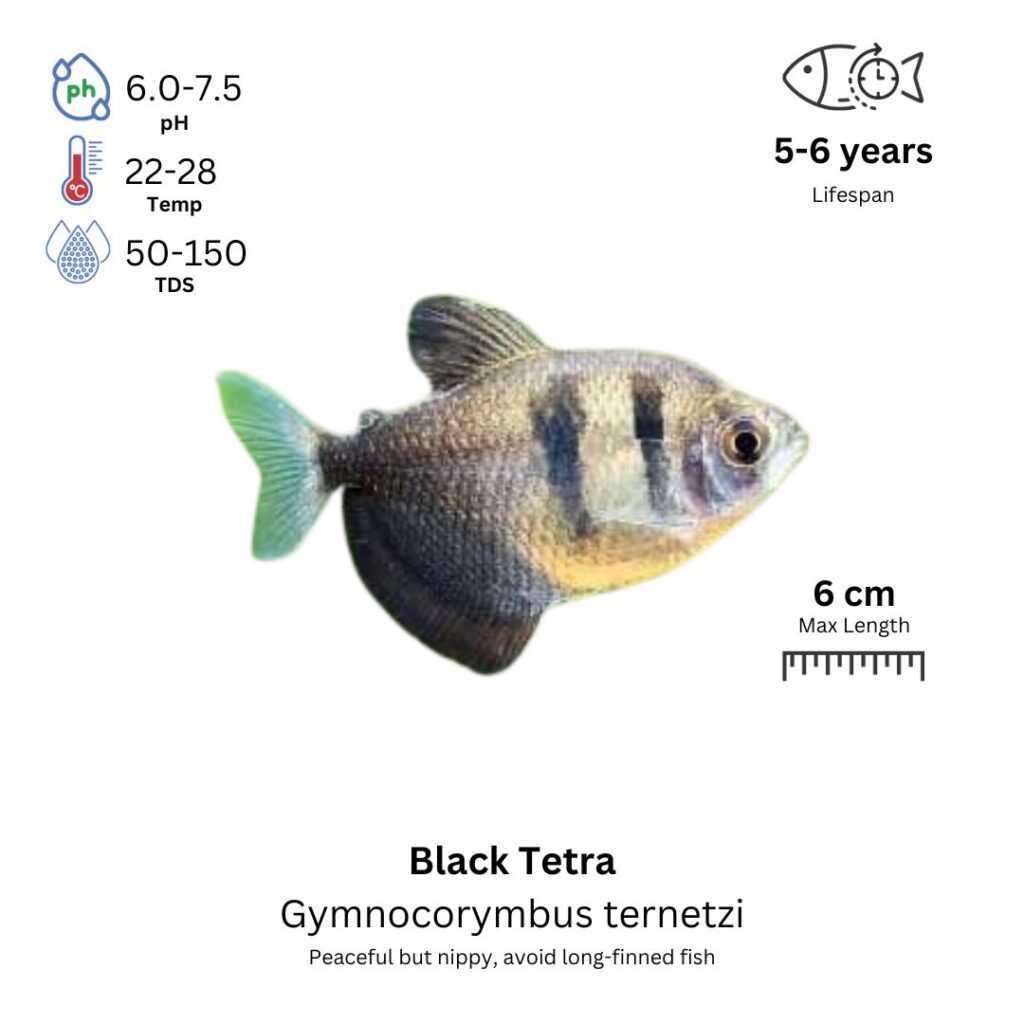Black Tetra
Gymnocorymbus ternetzi

Description
The Black Tetra, also known as the Black Widow Tetra, is a small, peaceful fish with striking black coloration. The fish has a sleek, streamlined body with a dark, nearly black hue, especially on its body and fins. It typically has a dark, metallic appearance, which can vary slightly depending on water conditions, age, and diet. Males tend to be slightly smaller and more vibrant, while females are usually a bit larger and rounder. The Black Tetra has a distinctive triangular dorsal fin and is often found swimming actively in the middle to upper levels of the tank. These tetras are social and do best in schools, exhibiting their best colors and behavior when housed with other Black Tetras.
Habitat Origin
Native to the rivers and streams of South America, particularly in the Paraguay River basin, which spans Brazil, Argentina, and Paraguay. These fish are typically found in slow-moving waters with dense vegetation, where they thrive in calm and slightly acidic to neutral water conditions.
Aquarium
Ideal Number in Aquarium: At least 6 individuals, as they are schooling fish and feel more secure in groups.
Favorite Food

Black Tetras are omnivores and will accept a variety of foods, including high-quality flake food, micro pellets, and live or frozen foods such as brine shrimp, daphnia, and bloodworms. They will also graze on small algae and plant matter in the tank. A varied diet ensures they maintain vibrant colors and good health.
Behavior:
Black Tetras are peaceful and social fish that thrive in schools. They are active swimmers, often seen swimming in the middle or upper regions of the tank, where they exhibit coordinated swimming patterns. They are not aggressive and can coexist peacefully with other small, non-aggressive species. However, they should not be kept with larger or aggressive fish, as these may intimidate or harass them. They are generally calm but may become shyer if kept alone or in small groups.
Special Care:
Black Tetras thrive in a well-planted tank with plenty of hiding spots, such as plants, driftwood, and rocks. A fine gravel or sandy substrate is ideal for them to graze and forage naturally. Regular water changes and good filtration are important to maintain water quality, as these fish are sensitive to poor water conditions. These fish enjoy slightly acidic to neutral water conditions and benefit from stable water parameters. They should not be exposed to extreme changes in temperature, pH, or water hardness.
Compatibility with Other Fish:
Yes, Black Tetras are compatible with other peaceful species such as small tetras, rasboras, and catfish. They are ideal for community tanks with other non-aggressive species. Avoid keeping them with larger or more aggressive fish, as they may become stressed or become prey. Their peaceful nature and schooling behavior make them great for tanks focused on small, tranquil fish.
Breeding Setup
A separate breeding tank is highly recommended for Black Tetras to provide a controlled environment and protect the eggs and fry from being eaten by other fish. A 40-liter (10-gallon) tank is suitable, offering enough space for a breeding pair while maintaining stable water quality. Ideal water parameters include pH 6.0–7.0, temperature 24–28°C (75–82°F), and hardness 2–10 dGH. Use a gentle sponge filter to ensure calm water. A bare-bottom tank or fine gravel substrate works well, and Java moss, Hornwort, and floating plants like duckweed provide surfaces for eggs and shelter. Keep lighting dim to replicate their natural, shaded habitat.
Conditioning for Breeding
To prepare Black Tetras for breeding, feed them a high-protein, varied diet including live or frozen foods like brine shrimp, daphnia, and bloodworms, as well as high-quality flakes and pellets. This helps improve their health and spawning readiness. Perform 25% water changes every 2–3 days to maintain excellent water quality. Keeping the water temperature consistent is key to reducing stress and triggering breeding behavior.
Spawning
Spawning typically occurs early in the morning, with Black Tetras scattering their eggs over plants, substrate, or decorations. A healthy female can produce up to 100 eggs in one session. These adhesive eggs stick to various surfaces. After spawning, remove the adult fish immediately, as they may consume their own eggs. Transferring the adults back to the main tank helps maximize the survival rate of the eggs and developing fry.
Fry Care
Black Tetra eggs hatch within 24–36 hours, and the fry will initially rely on their yolk sacs for nutrition. Once free-swimming, begin feeding infusoria or liquid fry food. As they grow, introduce baby brine shrimp or microworms. Maintain excellent water quality with daily 10–15% water changes, and ensure the temperature remains stable between 24–28°C. Monitor ammonia and nitrite levels closely, as fry are highly sensitive to toxins and poor water conditions.
Key Considerations
Black Tetras are typically ready to breed at 6–12 months of age. Males are slimmer and show more intense black coloration, while females are rounder, especially when carrying eggs. To ensure successful breeding, avoid stress caused by sudden water parameter shifts or overcrowding. Keep the breeding tank peaceful, clean, and well-maintained to support healthy development from eggs to juvenile fish.
